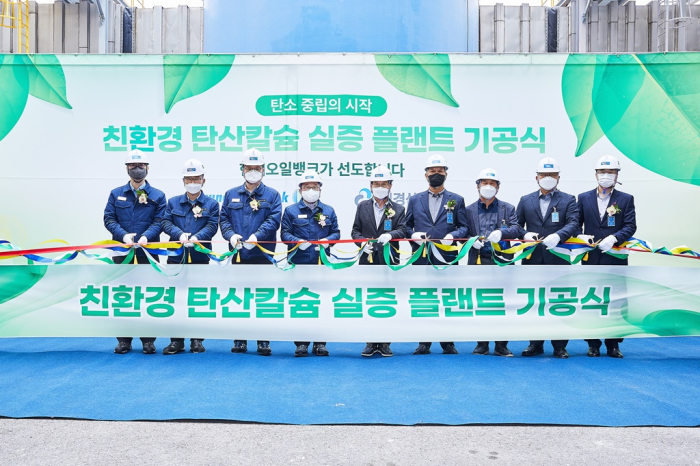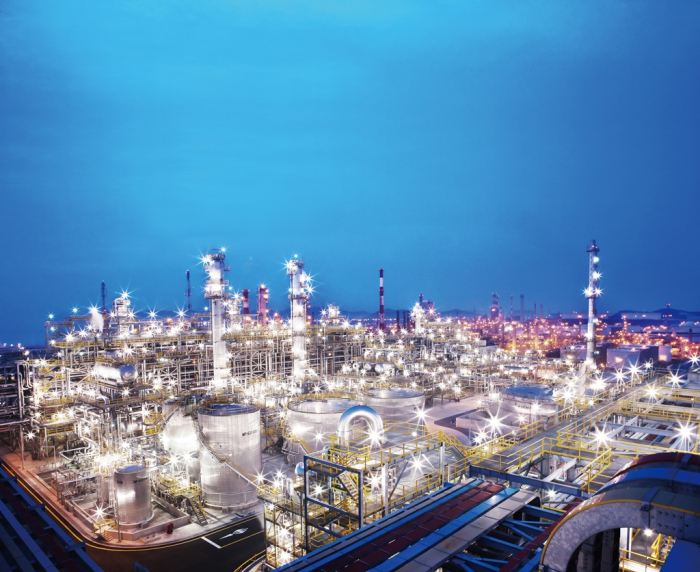Carbon neutrality
Hyundai Oilbank to make building, paper materials with carbon
To recycle 500,000 tons of desulfurized gypsum and reduce 100,000 tons of greenhouse gas through the CCU projects
By Dec 06, 2021 (Gmt+09:00)
3
Min read
Most Read
LG Chem to sell water filter business to Glenwood PE for $692 million


Kyobo Life poised to buy Japan’s SBI Group-owned savings bank


KT&G eyes overseas M&A after rejecting activist fund's offer


StockX in merger talks with Naver’s online reseller Kream


Mirae Asset to be named Korea Post’s core real estate fund operator



South Korean refiner Hyundai Oilbank Co. is set to produce eco-friendly materials for construction and paper with by-products of refining as it seeks carbon capture, utilization and storage (CCUS) businesses.
Hyundai Oilbank, the country’s first company that manufactures and commercializes other goods with carbon, aims to secure a future growth engine with eco-friendly products that help cut carbon.
The CCUS is a key to achieving carbon neutrality by 2050 since the technology reduces carbon emission when it is difficult to slash dependence on fossil fuels in a short term. The CCUS is divided into carbon capture and storage (CCS) and carbon capture and utilization (CCU). The CCS costs much since it needs land for facilities such as a closed refinery to bury carbon. So, Hyundai Oilbank is slated to focus more on the CCU.
“The CCU is a technology to reduce greenhouse gas, recycle resources and protect the environment at the same time,” said Hyundai Oilbank CEO Kang Dal-ho.
PAPER MATERIALS FROM DESULFURIZED GYPSUM
Late last month, Hyundai Oilbank broke ground to build a test plant for eco-friendly precipitated calcium carbonate to be completed in March 2022 at its refinery complex in Daesan, South Korea, according to the refining industry sources on Dec. 5. The precipitated calcium carbonate used to whiten paper or polish plastics is made by carbonating quicklime.
Hyundai Oilbank succeeded in extracting quicklime materials that have been mined in nature from desulfurized gypsum, a by-product of refining. The company developed technology to produce precipitated calcium carbonate by reacting the quicklime materials from desulfurized gypsum with carbon. It applied for an original patent in January.
Hyundai Oilbank agreed with Taekyung Industrial Co., South Korea’s top precipitated calcium carbonate maker, to assess the quality of the mineral for producing high-quality paper from the plant with an annual capacity of 100 tons of the test materials and commercialize the product.
The refiner is set to commercialize it after checking the market’s response on the eco-friendly mineral. It aims to build a factory to manufacture 170,000 tons of high purity precipitated calcium carbonate a year and 150,000 tons of anhydrous gypsum, a construction material, with 250,000 tons of desulfurized gypsum. It will store and utilize 70,000 tons of carbon during the process, while the production is more eco-friendly than obtaining calcium carbonate from lime mines.
The refining unit of Hyundai Heavy Industries Holdings Co. targets overseas markets, given the domestic precipitated calcium carbonate market size of 150,000 tons per year.
CONSTRUCTION MATERIALS
Hyundai Oilbank has been working with DL E&C Co., a South Korea’s builder, on CCU projects since August to produce construction materials such as cement and concrete with desulfurized gypsum and carbon.
The refiner aims to build a plant that can produce 100,000 tons of the materials in the Daesan complex by end-2022 with a plan to raise the capacity to 280,000 tons in the future. DL E&C was set to work on engineering, procurement and construction of the factory while using the eco-friendly cement and concrete manufactured from the eco-friendly carbonated products for other construction and civil engineering projects.

Through the two CCU projects, Hyundai Oilbank expected to recycle 500,000 tons of desulfurized gypsum a year and cut 100,000 tons of greenhouse gas by capturing and utilizing carbon.
Earlier this year, Hyundai Oilbank announced a strategy to reduce its refinery business from the current 85% of its portfolio to as low as 40% by 2030 to slash its carbon emissions and diversify its energy mix.
It plans to seek three new businesses – blue hydrogen that collects and recycles carbon generated from hydrogen production facilities in the refinery; eco-friendly materials utilizing by-products of refining; and "white bio" fuel produced with biomass.
Write to Kyung-Min Kang at kkm1026@hankyung.com
Jongwoo Cheon edited this article.
More to Read
-

-
 Renewable energyHyundai Oilbank to develop eco-friendly e-fuels with Danish firm
Renewable energyHyundai Oilbank to develop eco-friendly e-fuels with Danish firmNov 05, 2021 (Gmt+09:00)
1 Min read -
 Hydrogen economyHyundai Oilbank to make hydrogen fuel cell components from 2023
Hydrogen economyHyundai Oilbank to make hydrogen fuel cell components from 2023Aug 26, 2021 (Gmt+09:00)
3 Min read -

Comment 0
LOG IN


